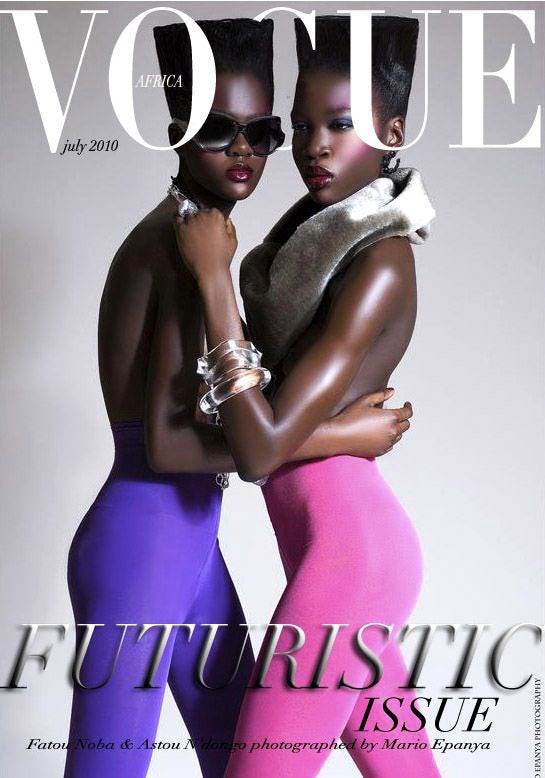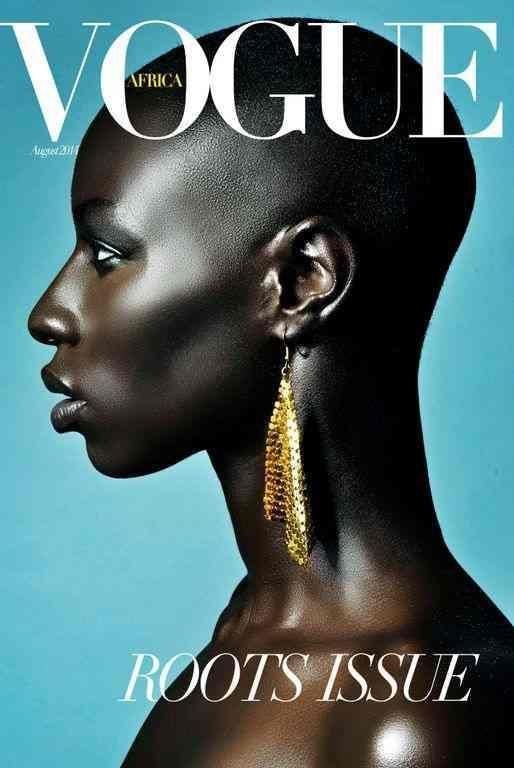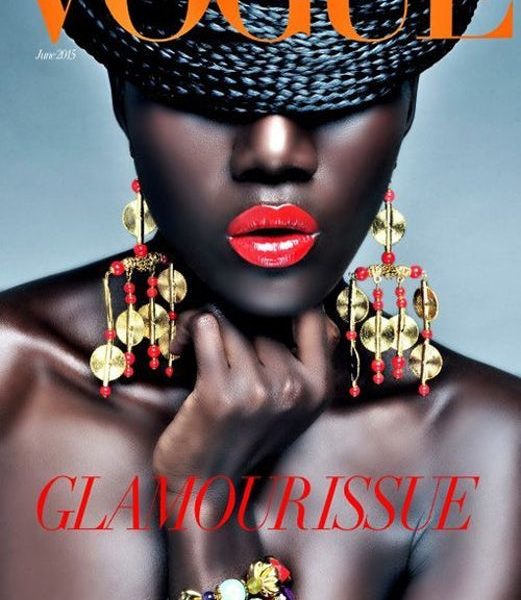Africa is in the midst of a frenzied period of fashion weeks right now. From Lagos to Johannesburg and beyond, a number of industry showcases have been pulling together a disparate but intoxicating mix of African designers, elite African clients and media from both near and far. Fashion diversity on the continent certainly reaches dizzyingly proportions but there is one thing that has united many of the powerful, wealthy and stylish individuals, whether they’re watching from the front row, backstage or just on the sidelines: “Where is Vogue Africa?”
While Vogue’s publisher Condé Nast International does have regional editions of Vogue for the Middle East and Latin America, there is still no edition for Africa — or any individual African country. The fact that other international women’s fashion magazines do have a presence on the continent signals that there is not only an appetite, but also a market for upmarket titles. The South African edition of Elle, for example, has been creating fashion editorials and selling advertisements since 1996. African fashion industry leaders are now, once again, asking why Vogue is nowhere to be seen.
As far back as 2010, a Cameroonian photographer and makeup artist by the name of Mario Epanya released a series of fictional Vogue Africa covers in a bid to pose this exact question and to simultaneously convey a visionary message. More recently, Naomi Campbell in an interview during the Arise Fashion Week event held in Nigeria, said, “There should be a Vogue Africa. We just had Vogue Arabia — it is the next progression.”
Condé Nast International’s recent decision to launch a Vogue for the Czech Republic and Campbell’s calls for a Vogue Africa have now sparked fierce conversations on the continent and beyond — and there is a broad spectrum of opinions expressing either delight, doubt or outright dismissal. Personally, I believe that there is no time like the present and have started an online campaign calling for #VogueAfricaYourTimeIsNow.
The business case is strong
For sceptics who still see Africa in a dim light and therefore believe that a prestigious magazine like Vogue doesn’t belong here, they are missing the fast-paced renaissance and energy that is flowing into almost every corner of the continent. It is a movement that is underpinned by a largely positive economic story with good long-term fundamentals and sweeping social and cultural changes that are being amplified by transformative technological change.
Despite Africa’s many well-documented challenges, the International Monetary Fund still projects the African region as a whole to be the world’s second fastest growing economy to 2020. According to the IMF’s Regional Economic Outlook in October 2017, top performing economies like Ghana, Ethiopia, Côte d’Ivoire and Senegal are forecast to enjoy GDP growth of more than 7 percent in 2018.

A fictional interpretation of Vogue Africa by Mario Epanya | Source: Courtesy
Over a 15-year period, Africa still shows a picture of real GDP growth, albeit more divergent, with some markets slowing considerably (mainly oil exporters and North African countries) and others across East Africa showing markedly accelerating growth alongside West African nations like Ghana.
For naïve naysayers who still believe that Africans are not wealthy enough for a Vogue Africa, we need only point to the indisputable appetite for luxury goods as evidenced by brands like Gucci, Prada and Louis Vuitton, to name a few, that have established stores on the continent to meet the needs of affluent Africans shopping in their home markets.
Poverty is of course hugely problematic for large swaths of the population. But this is only one part of the story. According to New World Wealth, an estimated $5.9 billion was generated by the African luxury sector in 2016. The rise of an affluent class is another key factor in evaluating new markets for a media brand like Vogue, which is mostly reliant on revenue from luxury brand advertisers. According to AfrAsia Bank Africa Wealth Report 2017, the current number of 145,000 High Net Worth Individuals (US dollar millionaires) on the continent is expected to rise 36 percent by 2026. Their current combined wealth holdings amount to approximately $800 billion.
As key fashion cities like Lagos, Johannesburg and Nairobi are seeing a proliferation of homegrown luxury lifestyle concept stores that boost the overall luxury landscape, other high-growth cities like Addis Ababa, Dar es Salaam and Kampala are expected to witness an increase of millionaires by more than 90 percent from 2016 to 2026.
By offering a combination of both luxury international and high-end African fashion brands to customers in contemporary and premium retail environment, it increases the likelihood of advertisers, thereby strengthening the case for any publisher deciding whether to enter a new market or region.
Proof of a vibrant fashion ecosystem
Another concern some may have is the strength of the African fashion industry and fashion scene to support a local edition of Vogue. With two fashion power centres — Lagos in the west, Johannesburg in the south — and cities like Nairobi and Addis Ababa in the east showing a rising influence, the vibrant fashion and design ecosystem is still fragmented. But it still plays a greater role in driving awareness for African fashion across the continent and the world, bringing growth and significance to local fashion industries.
There has also been a rise of multiple fashion weeks that occur throughout the year with designers, stylists, influencers and bloggers, fashion schools and both online and offline retail, all taking part.
Another critique of a potential Vogue Africa — mostly by Africans themselves — is the scope and mission of such a title. “Africa is a continent, with 54 diverse countries; why should we all be lumped together,” is a refrain I’ve heard more than a few times.
Vogue Africa should not be seen as some far-fetched idea — we are a fashion force to be reckoned with.
But there is strength in numbers. Having a regional title suggestive of a pan-African approach does not deny or reject any individual country or the extraordinary diversity that exists throughout the continent. Rather, it leverages the rich cultural diversity of all that Africa has to offer, and does it in a more representative fashion than an edition dedicated to just one market would — like a Vogue South Africa.
In a newly aligned, recalibrated world, African fashion and talent from all over the continent is ready to leapfrog onto the global fashion stage. Vogue is one of the most recognised global fashion media brands today, so giving a voice to African creativity, African beauty and African prosperity in its very own context would also provide us with a global platform to launch our brands, designers, models and role models to the rest of the world.
Contrary to what others have expressed, supporting this idea is not a matter of seeking external validation. I think it’s quite the opposite. This is about seeing the growth and change in the entire continent and respecting it. Vogue Africa should not be seen as some far-fetched idea — we are a fashion force to be reckoned with. Vogue Africa could tap directly into that power and growing influence. I would argue that the African continent is perfectly positioned to both actively participate in and positively benefit from the transformative macro-economic and consumer shifts shaping the future of fashion.
Adding to the African zeitgeist
To allow the eye to travel and showcase pan-Africa’s extraordinary fashion potential, to capture the visual aesthetics of Africa’s vast past in present and future form, and to reflect and elevate contemporary and diverse narratives, is what a famous brand like Vogue can and should do in digital and possibly even print format.
It is the audience of an African edition of Vogue that could collectively continue stitching the modern narrative together, strengthening the notion that we are brothers and sisters with no borders whilst still taking pride in our continent and in our respective countries.
Lupita Nyong’o is doing it on the most global of platforms, and so is Trevor Noah. As we all know, fashion is more than just clothes. It’s business, art and culture too. Of course, telling our own stories and owning the modern narrative as it evolves is incredibly important but is not mutually exclusive. Whether a Vogue Africa launches or not, we still have the freedom to create and develop our own magazines, or other ways to compete with a potential Vogue Africa for share of the pockets, hearts and minds of the rising consumer class.

A fictional interpretation of Vogue Africa by Mario Epanya | Source: Courtesy
Vogue Africa would be riding the wave of the fashion and cultural zeitgeist that is focused on Africa and the African diaspora. Rather than just using this movement that is sweeping the world to its own advantage, it could add to the movement too. Vogue Africa should be a cosmopolitan and globally minded platform for the highest levels of African creativity, African design and African aesthetics.
Positively reinforced by the runaway global success of blockbuster movie “Black Panther,” events like the first Afropunk festival on African soil earlier this year in Johannesburg, the opening last year in Cape Town of Zeitz Museum of Contemporary Art Africa (Zeitz MOCAA) — the largest museum of contemporary African art in the world— and recent milestones like the appointment of Edward Enninful as editor-in-chief at British Vogue and Virgil Abloh as Louis Vuitton’s new menswear designer, there is no better time to ask, “What about Africa?”
What does the publisher of Vogue say?
I contacted Karina Dobrotvorskaya, president of Condé Nast International (CNI) new markets and editorial director of brand development, who shared some key learnings from the launch of other international editions of Vogue, which tell of a varied and bespoke approach. “We’re extremely excited by the possibilities of launching titles globally and beyond what people may perceive as the traditional Condé Nast home territories,” she says.
“Regarding Vogue Africa, it is something that we are looking at, but we don’t want to rush or make any quick decisions. When launching any Vogue, it’s important for us to work with the right team and launch at the right time,” she adds.
“A completely new departure and a strategy we might duplicate in other markets, like Africa where distribution of print edition might be challenging,” is to launch the digital edition first before a print version is sold on the newsstands like the company did when it launched Vogue Arabia. “CNI is a platform agnostic publisher, so when we decide to enter a market we always want to do it in a way that fits the culture and the market dynamics to ensure it is as successful as possible.”
Although, similar to a Vogue Arabia —which alongside Vogue Latin America sets a precedent for regional editions — the strategy could be bolstered by adding key international cities into the distribution mix where there’s a significant diaspora market and where affluent Africans have second homes. This could help boost the feasibility and scale of the business model.
My experience crisscrossing Africa, visiting ten cities in eight countries to attend twelve different fashion week platforms, in some cases multiple times, over the last five years has been just as enlightening as it has been deeply inspirational, re-affirming the sentiments echoed in the #VogueAfricaYourTimeIsNow campaign. I do not think African fashion, for example, should be represented in a limited way and only to the extent that it is seen in other Vogues around the world.
Join me in support of an African edition for Vogue with the #VogueAfricaYourTimeIsNow hashtag to remind decision-makers that we have enough creative talent to cover, enough aspirational readers, enough affluent clients to buy the goods and — as some say in true renaissance style — we are not asking for a seat at the table, but are now making new tables.
This article was published with permission from Leanne Tlhagoane who is the founder of RefashionAfrica.com, a platform dedicated to African fashion.
Originally published on The Business of Fashion.

